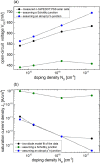Junction formation and current transport mechanisms in hybrid n-Si/PEDOT:PSS solar cells
- PMID: 26278010
- PMCID: PMC4538380
- DOI: 10.1038/srep13008
Junction formation and current transport mechanisms in hybrid n-Si/PEDOT:PSS solar cells
Abstract
We investigated hybrid inorganic-organic solar cells combining monocrystalline n-type silicon (n-Si) and a highly conductive polymer poly(3,4-ethylenedioxythiophene)-poly(styrene sulfonate) (
Pedot: PSS). The build-in potential, photo- and dark saturation current at this hybrid interface are monitored for varying n-Si doping concentrations. We corroborate that a high build-in potential forms at the hybrid junction leading to strong inversion of the n-Si surface. By extracting work function and valence band edge of the polymer from ultraviolet photoelectron spectroscopy, a band diagram of the hybrid n-Si/
Pedot: PSS heterojunction is presented. The current-voltage characteristics were analyzed using Schottky and abrupt pn-junction models. The magnitude as well as the dependence of dark saturation current on n-Si doping concentration proves that the transport is governed by diffusion of minority charge carriers in the n-Si and not by thermionic emission of majorities over a Schottky barrier. This leads to a comprehensive explanation of the high observed open-circuit voltages of up to 634 mV connected to high conversion efficiency of almost 14%, even for simple planar device structures without antireflection coating or optimized contacts. The presented work clearly shows that
Pedot: PSS forms a hybrid heterojunction with n-Si behaving similar to a conventional pn-junction and not, like commonly assumed, a Schottky junction.
Conflict of interest statement
The authors declare no competing financial interests.
Figures








References
-
- Shirakawa H., Louis E. J., MacDiarmid A. G., Chang C. K. & Heeger A. J. Synthesis of Electrically Conducting Organic Polymers : Halogene Derivatives of Polyacetylene, (CH)x. J. C. S. Chem. Comm 578–580 (1977).
-
- Xia Y., Sun K. & Ouyang J. Solution-processed metallic conducting polymer films as transparent electrode of optoelectronic devices. Adv. Mater. 24, 2436–2440 (2012). - PubMed
-
- Kirchmeyer S. & Reuter K. Scientific importance, properties and growing applications of poly(3,4-ethylenedioxythiophene). J. Mater. Chem. 15, 2077 (2005).
-
- Pietsch M., Bashouti M. Y. & Christiansen S. The Role of Hole Transport in Hybrid Inorganic/Organic Silicon/Poly(3,4-ethylenedioxy-thiophene):Poly(styrenesulfonate) Heterojunction Solar Cells. J. Phys. Chem. C 117, 9049–9055 (2013).
-
- Kim J. Y., Jung J. H., Lee D. E. & Joo J. Enhancement of electrical conductivity by a change of solvents. Synth. Met. 126, 311–316 (2002).
LinkOut - more resources
Full Text Sources
Other Literature Sources

